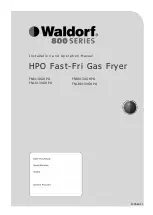
8
NOTE: ALL GAS FITTING MUST ONLY BE CARRIED OUT BY AN AUTHORISED PERSON.
This appliance can be configured to have underside or rear entry gas supply.
To convert this appliance, see the Gas Supply Connection Location Conversion section of this manual
for instructions.
- Flexible Hose Connection
If a Gas Hose assembly is used to connect this appliance, hose and all fittings must have a minimum
¾
” (Natural Gas) or ½” (LPG) inside bore diameter to ensure gas flow rate capacity required by this
appliance is achieved.
This must be verified by operating pressure testing at maximum gas supply demand condition.
The Gas Hose assembly should also be classified for use in commercial kitchen conditions, appliance
will be used in.
Recommended Gas Hose Assembly Specification:
- AS/NZS 1869 Class B or D compliant or equivalent, that meets the following requirements:-
1.
It is essential that the gas supply is correct for appliance being
installed and that adequate supply pressure and volume are
available. Carry out the following checks before installation:-
a. Gas Type the appliance has been supplied for is show n
on coloured stickers located above the gas connection point
and next to the rating plate. Check that this is correct for gas
supply the appliance is being installed for. Gas conversion
procedure is shown in this manual.
b. Supply Pressure required for this appliance is show n in
‘Specifications’ section of this manual. Check gas supply to
ensure adequate supply pressure exists.
c. Input Rate of this appliance is show n on Rating Plate
fitted to inside of access door and in ‘Specifications’ section of
this manual. Input rate should be checked against available
gas supply line capacity. Particular note should be taken if
appliance is being added to an existing installation.
NOTE: It is important that adequately sized piping runs directly to connection joint on the
appliance, with as few tees and elbows as possible to give maximum supply volume.
2.
A suitable joining compound which resists the breakdown action of LPG must be used on every gas
line connection, unless compression fittings are used.
Connection to appliance is
3
/
4
” BSP male.
NOTE: A Manual Isolation Valve must be fitted to the individual appliance supply line.
3.
Correctly locate the appliance into its final operating position, using a spirit level, adjust legs so that
unit is level and at the correct height.
4.
Connect gas supply to appliance.
5.
Check all gas connections for leakage using soapy water or other gas detecting equipment.
Fig 2
D
O
NOT
USE
A
NAKED
FLAME
TO
CHECK
FOR
GAS
LEAKAGES
.
Class
Max Working Pressure
at 23 ± 2ºC
Working Temperature Range
Resistance to Oil
B
7.0 kPa
- 20ºC to + 125ºC
Oil resistant lining and cover.
D
2.6 MPa











































